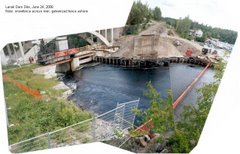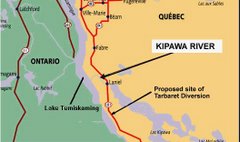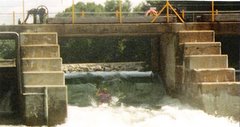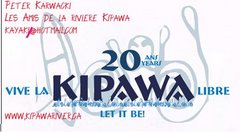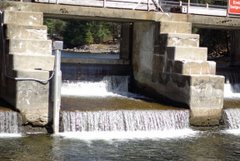The following smacks of fascist and totalitarianism. No problem, just
watch hockey and have a Timmy's.
image from National Geographic Documentary
http://www.dailymotion.com/video/xybxxr_national-geographic-inside-undercover-in-north-korea_news
http://www.thestar.com/opinion/commentary/2013/09/20/remove_the_muzzle_from_government_scientists.html
Remove the muzzle from government scientists
Politicians are twisting and hiding science that reveals flaws in their
policies.
By: David Schindler Published on Fri Sep 20 2013
Sean Kilpatrick / THE CANADIAN PRESS
Demonstrators on Parliament Hill protest research cuts and the
government's muzzling of Canadian scientists. (Sept. 16, 2013)
Most scientists are by nature introverts, happiest in the field or the
laboratory, willing to talk about their work if asked but not inclined
to be self-promoters. But on Monday, they demonstrated in public in
several Canadian cities to protest the muzzling of government scientists
and the de-emphasis of government environmental science.
That scientists would take the time and effort to demonstrate publicly
should be deeply disturbing to Canadians. It indicates some dramatic and
important changes in the purpose of government science departments.
In the 1960s and 1970s, government scientists were encouraged to speak
publicly about their work. The resulting science-based policies were the
envy of scientists and policy-makers around the world. Canada was the
first country to regulate phosphorus in sewage and detergents, leading
to the recovery of many lakes from algal blooms. Much of the science
behind that decision was done by government scientists. It was welcomed
by policy-makers eager to anchor their policies in solid science. Canada
also led global efforts to decrease emissions of ozone-depleting
chemicals, resulting in the Montreal Protocol.
A decade later, the transparency in government science began showing the
first signs of weakening. Scientists were no longer encouraged to speak
publicly on their work, but they were not prevented from doing so. They
were warned to avoid directly criticizing government policies, even
environmentally harmful ones. Rebukes were mild for a scientist who
challenged his political masters. At worst, a scolding letter was “put
on your file.”
Such tightening of public communication was one reason I left government
science for academia. In ensuing years, control over science and
scientists has been slowly tightened by politicians and bureaucrats
under both Conservative and Liberal governments, who feared that science
would challenge their ideology and their policies.
Even so, there were successes, such as policies to control acid rain,
based largely on science from government departments. But there were
also failures, as bureaucrats and politicians ignored science and
silenced government scientists to make weak policies that collapsed the
cod fishery and compromised the salmon runs of the Nechako River.
Despite repeated budget cuts, government science staggered on, doing
sometimes remarkable work, using clever liaisons with scientists in
universities and other countries to make important work publicly known.
During this period, I gave many lectures warning that government science
was on a dangerous path. No one seemed to notice.
It remained for the Harper Government to deliver the coup de grâce to
government science. Shortly after it took office, scientists were told
they must have permission from bureaucrats to speak publicly.
Bureaucrats and communications officers issued “speaking lines” that
must be used to avoid criticism of policies. The permitted lines were
often so inane that most scientists chose to remain silent rather be
embarrassed by using them.
Often, obtaining permission took so long that the opportunity to speak
had passed. On issues of particular international sensitivity such as
greenhouse gases, scientists were accompanied to public meetings by
communications “handlers” to ensure that they did not utter any words
that would embarrass policy-makers. Scientists were advised to avoid the
media if possible, using tactics copied from training in bear avoidance
“walk slowly away, maintaining eye contact.” Similar tactics were used
by the Soviet Union to suppress scientific communication during the Cold
War, when KGB agents shadowed scientists participating in international
meetings.
Other actions were taken to ensure there would be less pesky science
done by government departments to challenge the Conservatives’
pro-development agenda. The government divested itself of the
Experimental Lakes Project, government contaminants programs, climate
projects and the Arctic PEARL project. The Fisheries Act and the
Navigable Waters Act were changed to provide less protection, while
expediting large industrial developments.
The Canadian public is beginning to see the problem, as scientifically
misleading and downright fallacious statements are made by ministers on
issues from greenhouse gas emissions to oilsands and protection of
fisheries. Most people are aware that a functioning democracy depends on
an informed electorate. Most also know that we, the taxpayers, pay the
bills for government science and endure the consequences of the
environmental policies, whether they are grounded in good science or
not. We deserve to know what we are paying for.
We must take government science back from politicians who would twist or
hide science that reveals flaws in their policies. We deserve to know
the truth about the impacts of proposed developments on our environment,
in order to avoid mistakes that will be costly to future generations.
Government science once provided this information, and it must be
changed to do so again. The health of not only our environment, but of
Canadian democracy, depends on it.
David Schindler is Killam Memorial Professor of Ecology emeritus at the
University of Alberta. His 50-year scientific career has included 22
years as a federal government scientist.
http://www.thestar.com/opinion/commentary/2013/09/20/remove_the_muzzle_from_government_scientists.html
Remove the muzzle from government scientists
Politicians are twisting and hiding science that reveals flaws in their
policies.
By: David Schindler Published on Fri Sep 20 2013
Sean Kilpatrick / THE CANADIAN PRESS
Demonstrators on Parliament Hill protest research cuts and the
government's muzzling of Canadian scientists. (Sept. 16, 2013)
Most scientists are by nature introverts, happiest in the field or the
laboratory, willing to talk about their work if asked but not inclined
to be self-promoters. But on Monday, they demonstrated in public in
several Canadian cities to protest the muzzling of government scientists
and the de-emphasis of government environmental science.
That scientists would take the time and effort to demonstrate publicly
should be deeply disturbing to Canadians. It indicates some dramatic and
important changes in the purpose of government science departments.
In the 1960s and 1970s, government scientists were encouraged to speak
publicly about their work. The resulting science-based policies were the
envy of scientists and policy-makers around the world. Canada was the
first country to regulate phosphorus in sewage and detergents, leading
to the recovery of many lakes from algal blooms. Much of the science
behind that decision was done by government scientists. It was welcomed
by policy-makers eager to anchor their policies in solid science. Canada
also led global efforts to decrease emissions of ozone-depleting
chemicals, resulting in the Montreal Protocol.
A decade later, the transparency in government science began showing the
first signs of weakening. Scientists were no longer encouraged to speak
publicly on their work, but they were not prevented from doing so. They
were warned to avoid directly criticizing government policies, even
environmentally harmful ones. Rebukes were mild for a scientist who
challenged his political masters. At worst, a scolding letter was “put
on your file.”
Such tightening of public communication was one reason I left government
science for academia. In ensuing years, control over science and
scientists has been slowly tightened by politicians and bureaucrats
under both Conservative and Liberal governments, who feared that science
would challenge their ideology and their policies.
Even so, there were successes, such as policies to control acid rain,
based largely on science from government departments. But there were
also failures, as bureaucrats and politicians ignored science and
silenced government scientists to make weak policies that collapsed the
cod fishery and compromised the salmon runs of the Nechako River.
Despite repeated budget cuts, government science staggered on, doing
sometimes remarkable work, using clever liaisons with scientists in
universities and other countries to make important work publicly known.
During this period, I gave many lectures warning that government science
was on a dangerous path. No one seemed to notice.
It remained for the Harper Government to deliver the coup de grâce to
government science. Shortly after it took office, scientists were told
they must have permission from bureaucrats to speak publicly.
Bureaucrats and communications officers issued “speaking lines” that
must be used to avoid criticism of policies. The permitted lines were
often so inane that most scientists chose to remain silent rather be
embarrassed by using them.
Often, obtaining permission took so long that the opportunity to speak
had passed. On issues of particular international sensitivity such as
greenhouse gases, scientists were accompanied to public meetings by
communications “handlers” to ensure that they did not utter any words
that would embarrass policy-makers. Scientists were advised to avoid the
media if possible, using tactics copied from training in bear avoidance
“walk slowly away, maintaining eye contact.” Similar tactics were used
by the Soviet Union to suppress scientific communication during the Cold
War, when KGB agents shadowed scientists participating in international
meetings.
Other actions were taken to ensure there would be less pesky science
done by government departments to challenge the Conservatives’
pro-development agenda. The government divested itself of the
Experimental Lakes Project, government contaminants programs, climate
projects and the Arctic PEARL project. The Fisheries Act and the
Navigable Waters Act were changed to provide less protection, while
expediting large industrial developments.
The Canadian public is beginning to see the problem, as scientifically
misleading and downright fallacious statements are made by ministers on
issues from greenhouse gas emissions to oilsands and protection of
fisheries. Most people are aware that a functioning democracy depends on
an informed electorate. Most also know that we, the taxpayers, pay the
bills for government science and endure the consequences of the
environmental policies, whether they are grounded in good science or
not. We deserve to know what we are paying for.
We must take government science back from politicians who would twist or
hide science that reveals flaws in their policies. We deserve to know
the truth about the impacts of proposed developments on our environment,
in order to avoid mistakes that will be costly to future generations.
Government science once provided this information, and it must be
changed to do so again. The health of not only our environment, but of
Canadian democracy, depends on it.
David Schindler is Killam Memorial Professor of Ecology emeritus at the
University of Alberta. His 50-year scientific career has included 22
years as a federal government scientist.





